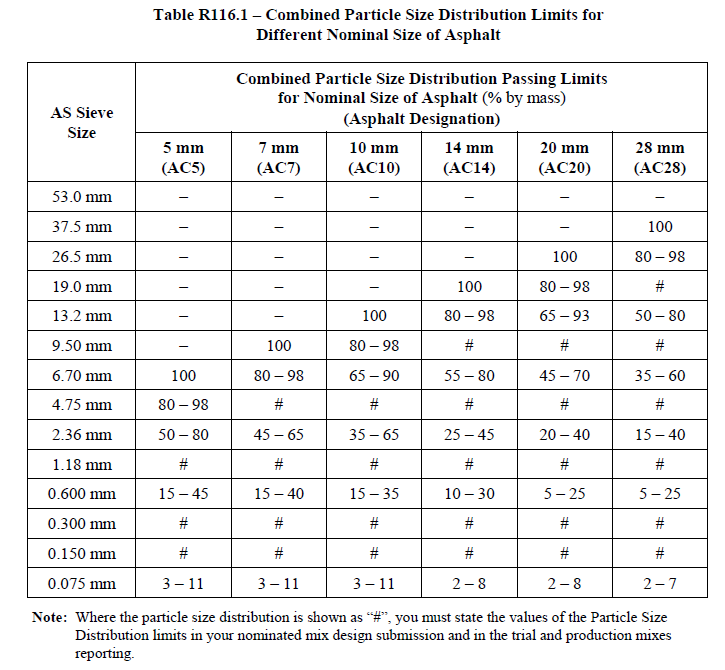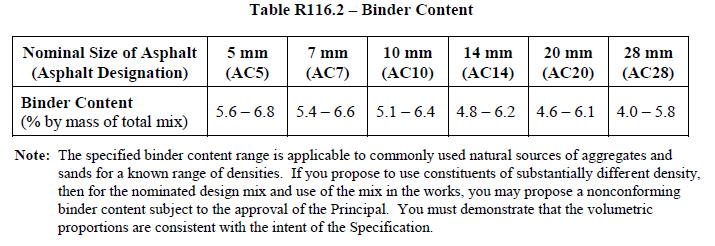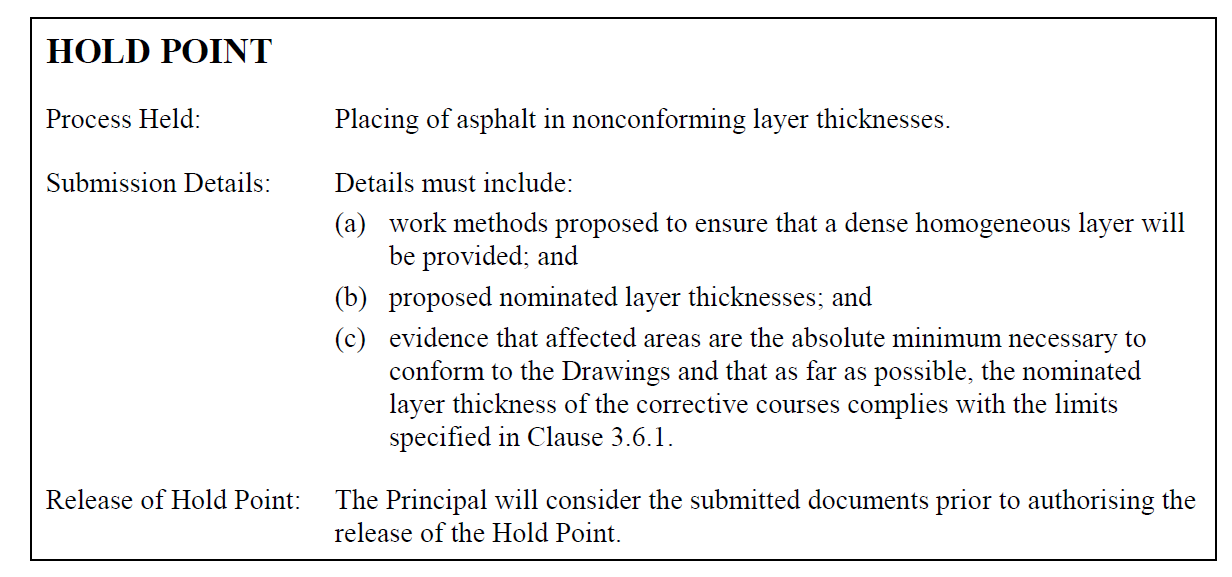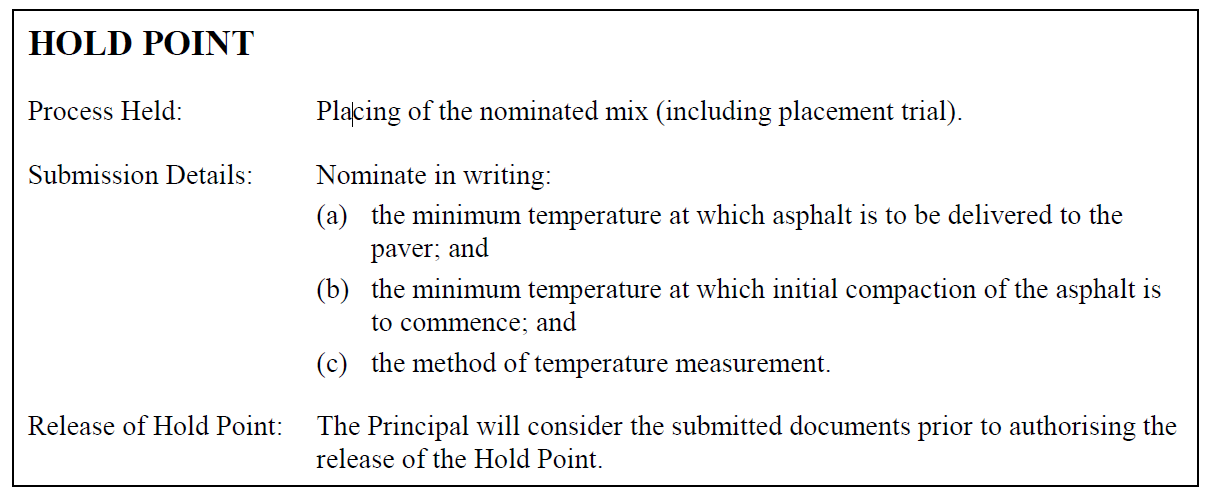Information
-
Inspection Title. R116- Heavy Duty Dense Graded Asphalt. (Ed 8 / Rev 4) .
-
Project Name: Tabulam New Bridge.
-
Location: BRUXNER HIGHWAY TABULAM
-
Contractor
-
Prepared by
-
Conducted on
Work Activity Record
2.3 NOMINATED MIXES
-
-
Has the principal released the Hold Point.
Cl 2.4 PRODUCTION of ASPHALT.
-
Cl 2.4.2.2 Do the actual combined PSD's remain within the limits of tables R116.1 . <br>
-
-
Cl 2.4.2.2 <br>Does the actual binder content remain within the limits of R116.2.
-
2.4.3 Asphalt Manufacturing Plant
-
Must produce auditable records. <br><br>
-
RAP materials must be dispersed uniformly throughout the mix.
-
Must have sufficiently capacity to supply asphalt for a continuous operation of the paver.
2.4.4 Storage and Handling
-
Cl 2.4.4 Storage and Handling. Binder<br>Heating and storage must comply with temperature and time limits set out in advisory note 7 published by AAPA. <br><br>Recirculate in delivery and/or storage tanks to get a uniform consistency. <br><br>
-
Recirculate in delivery and/or storage tanks to get a uniform consistency.
-
Have details been provided in the PQP of the procedures for acquisition, storage and handling of binder.
-
Cl 2.4.5 Manufacturing Temperatures. <br>Are thermometer registrations readable and accurate to within +-2 deg C. <br>The temperature of the asphalt must not have exceeded 175 dec C.
-
Cl 2.4.6 Is the sampling frequency of the asphalt as specified in Annexure R116/L
-
Cl 2.5 Transport of Asphalt. <br>Has sufficient transport capacity been allocated and provided. <br>Is efficient onsite management of asphalt deliveries being implemented.
Cl 3 PLACING ASPHALT.
-
Cl 3.1 Is the method of placing and finishing achieving:<br>A homogeneous product with a tight bound surface.<br>A uniform bond to the surface below<br>The finished pavement properties, specified in clause 4, within the specified tolerances. <br>No rapid cooling of the asphalt by application of water has taken place.
-
Cl 3.2 Has the surface been prepared in accordance with AS2150.
-
Cl 3.3 Is the asphalt being placed by a self propelled paving machine equipped and operated with automatic thickness control and automatic joint matching facility. <br>Hand placement only permitted for minor corrections of existing surface and in areas where placement with a paving machine is impractical. <br>Is the compaction procedure of the asphalt as detailed in the contractors PQP.
-
Cl 3.4 Has the traffic management been in accordance with the TMP and TGS. <br>Has traffic been kept off the surface until the asphalt has been placed, compacted and cooled sufficiently to carry traffic without damage to the work.
-
Cl 3.5 Has Asphalt or other material been prevented from adhering or entering grates, hydrants, valve boxes, service covers, bridge joints and other road fixtures <br>Has all waste asphalt been cleaned and removed from affected services and road fixtures.
-
Cl 3.6.1 Is the nominated layer thickness within the 3.0 to 5.0 times the nominal mix size. <br>
-
Cl 3.6.2 Has the Principal released the Hold Point. <br>
-
-
CL 3.7 Has the pavement temperature and wind velocity at the point of asphalt placing been measured and recorded. <br>Have the requirements of Cl 3.7 (a,b,c and D) been complied with. <br>Has tack coat or asphalt NOT been placed when the pavement surface is wet and/or rain is imminent.
-
Cl 3.8 Has the Hold Point been released.
-
Cl 3.9 Is the tack coat being applied to a surface that is clean, dry and free from loose material. <br>Is the tack coat applied evenly between .15 to .30 litres of residual bitumen per m2. <br>Has the contractor nominated in writing the proposed application rate prior to applying the tack coat. <br>Is a daily endorsed record of the average tack coat application per lot being submitted.<br>Is the tack coat intact at the commencement of asphalt placement. <br>
-
Cl 3.10 Is the procedure for the construction of joints detailed in the PQP. <br>Is this procedure being followed. <br>Has all loose, cracked and/or boney material removed from the paved material prior to placing the adjacent mat. <br>Longitudinal joints: coincide with the final traffic markings, ( unless otherwise approved by the principal). <br>Transverse joints; Formed at the commencement of each paving run.
Cl 4 FINISHED PAVEMENT PROPERTIES.
-
CL 4.1.1 Do Insitu air voids for the lots comply with table R116.7.
-
-
Cl 4.1.2 Has compaction control been carried out using statistical techniques as specified in RMS Q. <br>Bulk density can be determined from cores taken from site or nuclear density meter. <br>Are cores taken in accordance with AS 2891.9.2. <br>Air voids must be determined for: every change in underlying pavement material and layering within 300 mm of the surface to the layer being measured.<br>Every change in nominated mix and specific layer thickness. <br>
-
Cl 4.2.1 Is the course thickness between 45mm and 53 mm
-
Cl 5.3 Has the frequency for the testing of the asphalt been carried out in accordance with R116/L.
-
Cl 4.2.2 Have the CV and average values of each lot been done as per RMS Q
-
Cl 4.4.2 is there no ponding of water on the finished surface. <br>Does the surface comply with the straight edge tolerance in table R116.10.
Cl 5. CONFORMITY.
-
Cl 5.1 Is the asphalt homogeneous.
-
Cl 5.2 Have all sampling locations, frequencies and test methods been nominated in the PROJECT QUALITY PLAN.
-
Cl 5.3.1 Is the frequency of testing as specified in Annexure R116/L.
-
Cl 5.3.3 Has the results of testing been submitted with the required time frame <br>Test results for binder content , combined PSD and air voids in the laboratory compacted mix. (1 day) <br>Test results for the insitu air voids, course thickness and course shape within 3 working days of placing the asphalt.
-
Cl 5.5 have all non conformances been reported and closed out.
G22 Safety and G36 Environmental
G22 SAFETY
-
Have operators demonstrated their competence to operate the plant/equipment to the satisfaction of the contractor. <br>
-
Has a SWMS been developed.
-
Is each and every item of plant being used for its designated and intended purposes.
-
Have the attachments for plant and processes been approved and used in accordance with their design and purposes.
-
Is the correct PPE being worn
-
Were any unsafe practices observed. <br>
-
Good safe practices observed.
G36 ENVIRONMENTAL
-
R44 Cl 1.7 Were erosion and sediment controls in place prior to the removal of any topsoil.
-
Are Erosion and Sediment controls measures being installed and maintained.
-
Has mud been prevented from being deposited on roadways.
-
Have any environmental incidents or potential incidents been observed.
-
Good environmental procedures observed.
Compliance and Follow-up action.
-
Is the activity compliant.
-
Surveillance Officer
-
NCPN or memo number.
-
Follow up action
-
Product Non Conformance
-
System Non Conformance
-
Contractor generated NCR
-
Contractor generated a CAR
Matters arising
-
NCPN no
-
Contractors NCR no
-
CAR no
-
Closed out.
-
RMS representative's name











